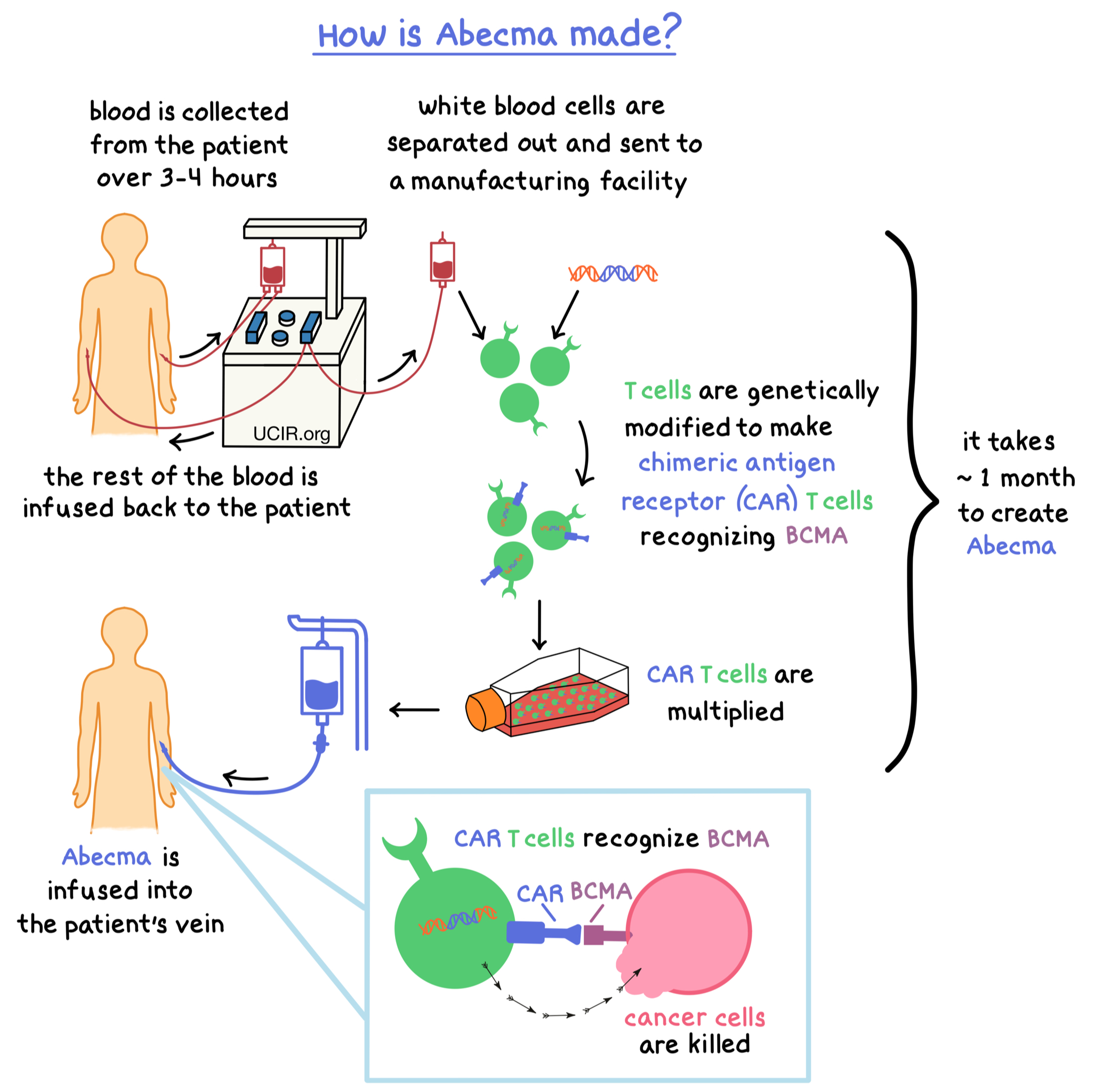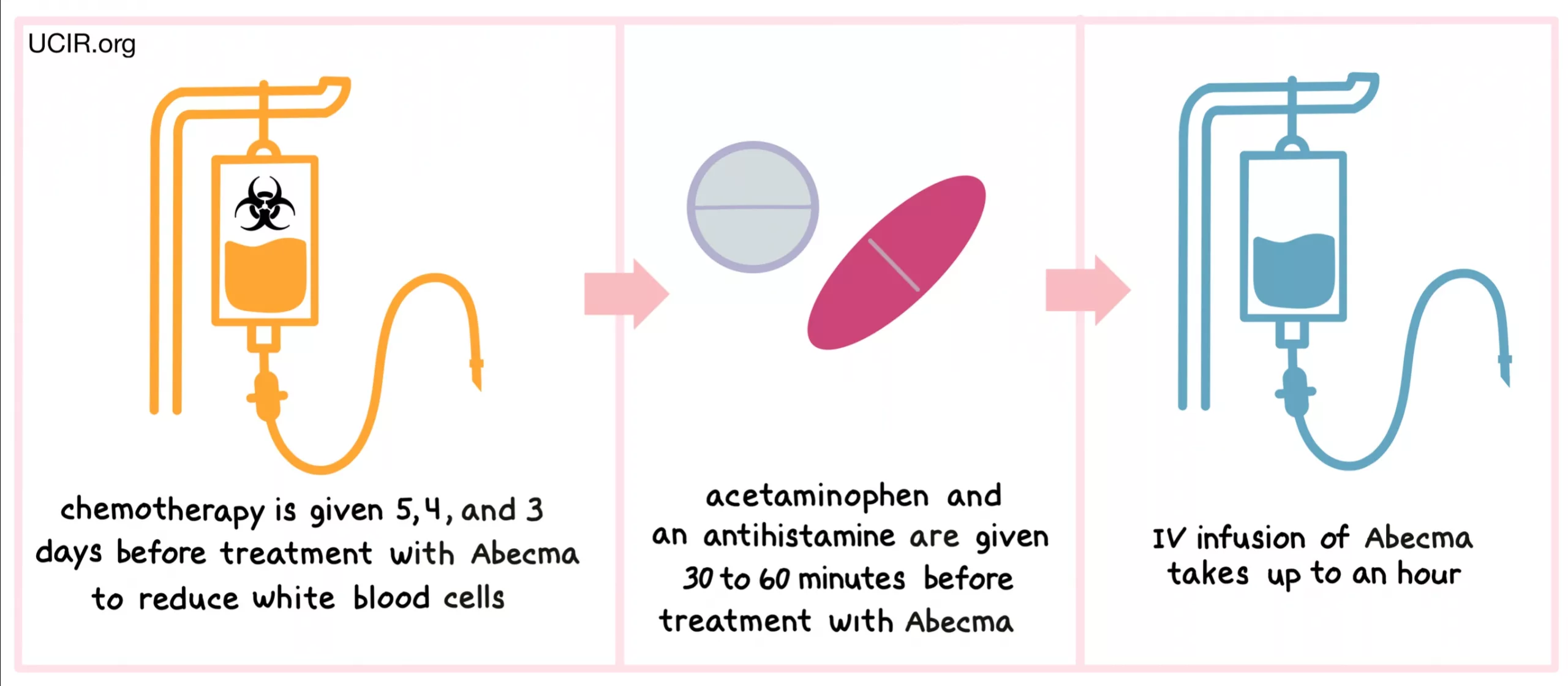
Let’s Get Right to It
All right, here’s a fact I can’t stop thinking about: some people’s immune cells are literally shipped off, “upgraded” in a lab, then sent back to them ready to hunt down cancer. That’s basically what you get with Abecma—except, of course, the process is a bit more involved (and, yeah, way cooler) than my amateur sci-fi explanation… but stay with me!
If you’re here because you, or someone you love, is facing multiple myeloma and considering Abecma, the big question bubbling up is probably how long does it take for Abecma to work? No small wonder. When everything feels urgent, “Wait and see” isn’t anyone’s favorite answer.
From Blood Draw to Hope: How the Process Starts
Let’s break it down in road-trip terms—this isn’t a weekend getaway, it’s an adventure with several pit stops. First up? Apheresis. That’s a fancy word for “let’s draw your blood, pull out the T-cells, and send the rest right back—like premium recycling for your immune system.” The session takes about 2 to 6 hours, and you’ll probably get snacks, maybe some bad hospital TV, and a stack of paperwork abecma for multiple myeloma style.
Ever donated blood and felt a little tired after? This is a smidge more involved, but it’s not a major ordeal. My friend Mark (not his real name, but he probably wouldn’t care if it was) described it as “a slow afternoon that made my arm feel like it ran a marathon.” No medals, but, hey, the payoff is just starting.
Genetic Makeover: Your Cells Get Superpowers
All right, now this is where science throws on a cape. Your white blood cells travel to a lab. (Yes—a real road trip! I would pay for a GPS tracker to see that journey.) Over about four weeks, they get a genetic touch-up, loaded with something called a “chimeric antigen receptor” (CAR). Translation? Now they’re trained to find a protein called BCMA, which only lives on multiple myeloma cells, and… well, let’s just say those cells aren’t going to like what happens next research on the ABECMA site.
Timeline Table: Step by Step
| Step | What Happens | How Long? |
|---|---|---|
| Blood collection | Apheresis at your center | 2–6 hours |
| Cell “training” | CAR T-cell creation in lab | ~4 weeks |
| Prep chemo | Short course lymphodepletion (chemo) | 3 days |
| Infusion | Your upgraded T-cells are given back | Up to 30 min infusion per bag |
| Intense monitoring | Watchful waiting at center/hospital | 7 days (may vary) |
| Close follow-up | Stay near center for side-effect watch | 2–4 weeks |
The Main Event: Infusion Day (AKA, Your Own Sci-Fi Scene)
If you’re still picturing some high-tech flick… you’re not wrong. Once your T-cells are ready, you get a little prep chemo—a three-day warm-up lap—so your body will welcome the newcomers. Then, it’s the main event: one-time infusion, up to 30 minutes per bag. Some folks get a single bag, others might have two. Either way, the nurses watch you like a hawk (in the good, deeply caring way).
Now, it’s less “laser show” and more quiet determination. This isn’t an instant-fix potion—think of it as planting seeds in a stubborn garden. The real magic starts…but it can be subtle at first.
Real Talk: When Are Results, Like, Actually Obvious?
Okay, this is the question. How long does it take for abecma to work after that infusion? Ready for the answer everyone dreads? (Sorry, but it’s the truth): It. Depends. But, let me haul out the details so it makes sense…
Typically, monitoring is most intense for the first week. That’s when your team’s looking for signs your immune system is, well, kicking into high gear. Technically, your “super-cells” begin attacking right away—they’re on the hunt as soon as they land. But do you feel better right away? Not so fast. The big improvements might take weeks—sometimes months.
Here’s what the research and real people say: most folks get progress checks around week 4 (that’s bloodwork, scans, maybe a bone marrow peek), and some already see lower myeloma markers. Others notice small but very real changes—like less bone pain, more energy, a scan that looks just a hint better data from KarMMa-3 trial).
Quick Story Break
I chatted with a patient (let’s call her Deanna) who said after three weeks, the pain in her hip “was suddenly, totally gone… like, I kept waiting for it to come back and it just didn’t.” For her, the change showed up before her doctor spotted it in labs. Another friend, Chris, didn’t see major shifts until his second month—he joked it felt like waiting for a slow cooker, not a microwave.
What’s Progression-Free Survival? And Why Does It Matter?
There’s a stat that gets tossed around if you’re Googling abecma for multiple myeloma: progression-free survival (PFS). This means, basically, “how many months before the myeloma tried to come back.”
The star result from trials? Folks getting Abecma had a median PFS of about 13.8 months. That’s triple what standard therapy offered—no small thing in a landscape where treatments feel like a revolving door according to clinical follow-up. Imagine what you could do with a year where the myeloma chills out. For a lot of people, that’s a gift—time to travel, garden, just feel… normal.
What About Side Effects?
This absolutely deserves its own moment. Abecma is a big push to the immune system and, yes, there are side effects that need close watch. Most common is something called cytokine release syndrome (CRS)—think fever, chills, like the worst flu ever, and it can show up within one day of infusion. That’s why patients stay in or near the treatment center at least a week for tight monitoring nurse experience with Abecma. Other possible effects: confusion, headaches, just generally feeling off. Don’t get spooked—teams are trained for exactly this, and most symptoms pass within days to a week.
Funny enough (sort of…), most people told me they were so closely watched they never worried about being “missed” if something happened. It’s like being the lead in a medical reality show. “I asked for more privacy,” one guy joked, “but they were there with ginger ale and cold packs before I could even buzz.”
Small Differences, Big Stories
Here’s something I wish every pro site said: how long does it take for abecma to work varies. Not just by your body, but by what you count as “progress.” For some, it’s blood tests moving the right way. For others, it’s just feeling a little more human. Maybe you notice you’re able to walk to the corner without catching your breath, or maybe the pain lightens up when you least expect it.
One caregiver shared she kept a “little wins” journal for her partner: first night without fever, first morning coffee without nausea, first laugh that wasn’t forced. These moments matter just as much.
So… When Will You Know?
Best answer: ask your team about your specific response markers and how they’ll check for them. For most? Plan to be closely monitored for two weeks, stick nearby the center for around 2–4 weeks, then start getting the regular updates every month or two abecma for multiple myeloma follow-ups are key for catching side effects and boosting peace of mind.
The magic number for “seeing real change” tends to be between a few weeks and 3 months. But if your labs are different from your neighbor’s, that’s completely normal. This is truly personalized medicine—because, well, it is your own cells leading the fight. And, don’t forget, no daily pills or repeated infusions: just riding out the results of that one, big treatment.
A Few Quick Tips for the Ride
| Problem | When? | What Helps? |
|---|---|---|
| Fever, chills, flu feelings (CRS) | Days 1–7 usually | Tell your care team ASAP, let them help |
| Fatigue | First month (and sometimes longer) | Rest, keep snacks handy, don’t push it |
| Worry (so normal!) | All the time | Reach out, journal, ask every question—seriously, none are silly |
| Wondering if it’s “working” | Weeks 4–12 (and beyond) | Keep regular labs/scans, look for wins—big and small |
Listening to Others on This Path
If you’re like me, you learn just as much from people who’ve been there as you do from all the science. I’ve met folks who say the journey with abecma for multiple myeloma totally changed the expectations they had—some got results faster than planned, others took their time but wound up with months and months of “normal,” something they thought had left their life for good.
Have you asked your doctor about the “prognosis” conversation, or what the markers of response could look like (lab numbers, pain, fatigue, appetite)? If you haven’t—now is the time. Really. Write those questions down, bring a friend who’s not afraid to be nosy, and don’t be shy about pulling out a notepad.
Why Patience Is a Superpower
If you’re feeling frustrated, discouraged, or like you’re living in a waiting room—please know you’re not alone. (Seriously, even the most positive people have their rough days). I honestly think the hardest part of all of this isn’t the infusion, or even the side effects—it’s the waiting game after, when you’re trying to trust your body to do something you can’t see in real-time.
But, I’ve seen (and heard about) so many outcomes where those patient, stubborn weeks pay off. For folks who respond to Abecma, there is often real, meaningful time with less disease, fewer symptoms, and more freedom. Time to plan, to hope, to maybe even be a little bored by how “normal” you’re feeling again.
A Little Uplift: You’ve Got Options
So, wrapping this up for now: how long does it take for abecma to work? Probably not as fast as you’d want (when is it ever?), but for many, it’s a few weeks to months—and the payoff, if you’re eligible, can be a longer, brighter stretch of life than you ever thought possible during active disease.
What next? Talk honestly with your team, write your questions down, and lean on other people who’ve done this. Check out resources like abecma for multiple myeloma for more stories and updates. Every single win—test results, an easier walk, getting back to baking—counts. And hey, keep me posted if you make a breakthrough banana bread on your new energy streak… I’ll swap you my favorite “start feeling normal again” playlist in return.
Above all, don’t lose your spark. You have every right to ask, to hope, and to hold out for a timeline that works for you. Here’s to finding out what’s actually possible, together.


















Leave a Reply
You must be logged in to post a comment.